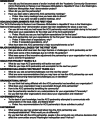Process evaluation of an academic-community-government partnership to reduce liver diseases attributable to hepatitis B virus
- PMID: 35619128
- PMCID: PMC9135310
- DOI: 10.1186/s12913-022-08062-7
Process evaluation of an academic-community-government partnership to reduce liver diseases attributable to hepatitis B virus
Abstract
Background: Racial/ethnic minorities have higher incidence and mortality rates of liver cancer, or hepatocellular carcinoma, than non-Hispanic Whites. As such, the Washington-Baltimore Metropolitan Area Hepatitis B Virus (WB-HBV) Demonstration Project, a community-based participatory research (CBPR)-driven academic-community-government (ACG) partnership, was established in 2019 to address disparities and implement strategies to improve the HBV screening and vaccination infrastructure for at-risk communities. CBPR is a partnership of community members, organizational leaders, and academic researchers with a common aim to collectively share and contribute their input at every phase of the project. Herein, we describe the process evaluation of the WB-HBV Project and extract themes and insights to benefit future ACG partnerships and community-engaged research. The process evaluation has been conducted to determine whether CBPR-driven partnership and programmatic activities have been implemented as intended and have resulted in building expanded research capacity for future ACG partnership HBV community-level initiatives.
Methods: A WB-HBV Project Task Force was convened and comprised of eight organizations: four community organizations, three government organizations, and one academic institution. Through a mixed-methods process evaluation, an online survey and key informant interviews were conducted to provide context for program implementation barriers and facilitators. Descriptive statistics were conducted, and interviews were recorded, transcribed, and thematically coded.
Results: The survey was completed by 14 of 20 partnership members (70.0%): two academic, eight community, and four government members. Partnership members showed general agreement across 14 domains: organization and structure of meetings; trust; decisions; impact; general satisfaction; strategic planning; ACG policy impact; community-based participatory research and government; participation in meetings; assessment of participation; partnership operations and capacity; communication; challenges/limitations associated with ACG involvement; and benefits compared to challenges associated with ACG involvement. Qualitative interviews were conducted with 15 of the 20 members (75.0%): two academic, nine community, and four government members. Four themes emerged: partnership involvement, project goals and accomplishments, project challenges and barriers, and partnership involvement in government or policy.
Conclusions: The process evaluation presents insights into developing strategies to enhance partnership functioning and increase the ability of present and future ACG partnerships to improve community health outcomes.
Keywords: Community health partnerships; Community health research; Community-based participatory research; Health disparities; Health outcomes.
© 2022. The Author(s).
Conflict of interest statement
The authors declare that they have no competing interests.
Similar articles
-
COVID-19's Impact on Community Resilience Practice: Lessons Learned from an Academic-Community-Government Partnership to Reduce HBV.Prog Community Health Partnersh. 2024;18(4):503-513. Prog Community Health Partnersh. 2024. PMID: 39925281 Free PMC article.
-
The Bidirectional Engagement and Equity (BEE) Research Framework to Guide Community-Academic Partnerships: Developed From a Narrative Review and Diverse Stakeholder Perspectives.Health Expect. 2024 Aug;27(4):e14161. doi: 10.1111/hex.14161. Health Expect. 2024. PMID: 39087753 Free PMC article. Review.
-
Lessons learned in measuring patient engagement in a Canada-wide childhood disability network.Res Involv Engagem. 2024 Feb 7;10(1):18. doi: 10.1186/s40900-024-00551-9. Res Involv Engagem. 2024. PMID: 38326926 Free PMC article.
-
Establishing New Community-Based Participatory Research Partnerships using the Community-Based Participatory Research Charrette Model: Lessons from the Cancer Health Accountability for Managing Pain and Symptoms Study.Prog Community Health Partnersh. 2018;12(1):89-99. doi: 10.1353/cpr.2018.0010. Prog Community Health Partnersh. 2018. PMID: 29606697 Free PMC article.
-
Community-based participatory research (CBPR) approaches in vaccination promotion: a scoping review.Int J Equity Health. 2024 Nov 5;23(1):227. doi: 10.1186/s12939-024-02278-1. Int J Equity Health. 2024. PMID: 39501299 Free PMC article.
Cited by
-
COVID-19's Impact on Community Resilience Practice: Lessons Learned from an Academic-Community-Government Partnership to Reduce HBV.Prog Community Health Partnersh. 2024;18(4):503-513. Prog Community Health Partnersh. 2024. PMID: 39925281 Free PMC article.
References
-
- Israel BA, Coombe CM, Cheezum RR, Schulz AJ, McGranaghan RJ, Lichtenstein R, et al. Community-based participatory research: a capacity-building approach for policy advocacy aimed at eliminating health disparities. Am J Public Health. 2010;100(11):2094–2102. doi: 10.2105/AJPH.2009.170506. - DOI - PMC - PubMed
-
- Unertl KM, Schaefbauer CL, Campbell TR, Senteio C, Siek KA, Bakken S, Veinot TC. Integrating community-based participatory research and informatics approaches to improve the engagement and health of underserved populations. J Am Med Inform Assoc. 2016;23(1):60–73. doi: 10.1093/jamia/ocv094. - DOI - PMC - PubMed
MeSH terms
Grants and funding
- 6CPIMP191177/U.S. Department of Health and Human Services Office of Minority Health
- 6CPIMP191177/U.S. Department of Health and Human Services Office of Minority Health
- 6CPIMP191177/U.S. Department of Health and Human Services Office of Minority Health
- 6CPIMP191177/U.S. Department of Health and Human Services Office of Minority Health
- 6CPIMP191177/U.S. Department of Health and Human Services Office of Minority Health
LinkOut - more resources
Full Text Sources
Medical
Research Materials


